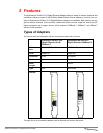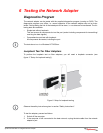
SysKonnect SK-98xx V2.0 Gigabit Ethernet Adapter
User Diagnostics (DOS) 39
The following conditions have to be met in order for Hot Plug to work on SysKonnect Gigabit Ether-
net adapters:
• The target system has PCI Hot Plug slots, i.e. the power can be switched on and off under the
control of the operating system.
• The adapter is installed in one of the PCI Hot Plug slots.
• The operating system supports PCI Hot Plug on the target system.
The drivers for the following operating systems support PCI Hot Plug:
• Windows 2000, Windows XP
• NetWare 4.20 and higher
• Solaris 7 and higher
Parity
The PCI bus parity is checked/generated on data paths of the receive/transmit data entering/leaving
the chip. This includes the PCI interface and the RAM buffer. Parity on the PCI bus is generated,
checked, and reported according to the PCI specification.
Sensors
The on-board sensors monitor all important voltages and the temperature on the network adapter.
The sensors are checked by the software. Upper and lower thresholds determine the area of safe
operation. Voltages and temperatures beyond the safe area will lead to appropriate error messages.
User Diagnostics (DOS)
The offline user diagnostics program (during diagnosis, the operation of the adapter can not be
maintained) provides system administrators and engineers with a profound tool to analyze the net-
work adapter and check adapter specific data (for details, see section "Diagnostics Program").
SysKonnect Network Control for Windows 2000
and Windows XP
SysKonnect offers a utility program for Windows 2000 and Windows XP. The “SysKonnect Network
Control” is part of the “SysKonnect Network Driver Installation Package” available for Windows 2000
and Windows XP. With the “SysKonnect Network Control” all SysKonnect adapters can be con-
trolled and configured. This tool displays the current configuration and status of the SysKonnect SK-
98xx family.
Predominantly, the “SysKonnect Network Control” helps to perform the following tasks:
• Configuration of the adapters and their corresponding ports
• Monitoring of the status of the adapter(s) installed
• Establishment of VLANs
• Building of teams / Enabling of link aggregation according to IEEE 802.3ad
• Enabling of RSF
• Enabling of RLMT for dual link adapters
• Monitoring of the voltage and temperature sensors
• Examining the attached cables by means of Virtual Cable Tester™ (VCT)


















